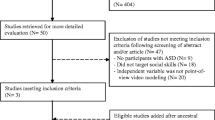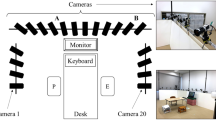Abstract
Adolescents with autism often experience pronounced difficulties with social communication, and novel interventions designed to improve core abilities are greatly needed. This study examines if providing immediate video feedback, an extension of video self-modeling, can aid adolescents with autism to self-identify strengths and irregularities from their social interactions. Using multiple baseline design across four participants, individuals engaged in naturalistic conversations wearing video recording glasses. During the intervention, videos were reviewed immediately and participants recognized when they were not following typical social-communicative convention. Based on observational data coded from videos, all four participants modified their behavior during subsequent conversations. Although adolescents with autism may hypothetically know to behave, viewing themselves on video may provide practical cues to support social insight and behavioral change.




Similar content being viewed by others
References
American Psychiatric Association. (2013). Diagnostic and statistical manual of mental disorders (DSM-5®). Philadelphia: American Psychiatric Publishing.
Bellini, S., & Akullian, J. (2007). A meta-analysis of video modeling and video self-modeling interventions for children and adolescents with autism spectrum disorders. Exceptional Children,73(3), 264–287.
Dolan, B. K., Van Hecke, A. V., Carson, A. M., Karst, J. S., Stevens, S., Schohl, K. A.,… & Hummel, E. (2016). Brief report: Assessment of intervention effects on in vivo peer interactions in adolescents with Autism Spectrum Disorder (ASD). Journal of Autism and Developmental Disorders, 46(6), 2251–2259.
Dowrick, P. W. (1999). A review of self modeling and related interventions. Applied and Preventive Psychology,8(1), 23–39.
Gates, J. A., Kang, E., & Lerner, M. D. (2017). Efficacy of group social skills interventions for youth with autism spectrum disorder: A systematic review and meta-analysis. Clinical Psychology Review,52, 164–181.
Grzadzinski, R., Carr, T., Colombi, C., McGuire, K., Dufek, S., Pickles, A., & Lord, C. (2016). Measuring changes in social communication behaviors: Preliminary development of the Brief Observation of Social Communication Change (BOSCC). Journal of Autism and Developmental Disorders,46, 2464–2479.
Horner, R. H., Carr, E. G., Halle, J., McGee, G., Odom, S., & Wolery, M. (2005). The use of single-subject research to identify evidence-based practice in special education. Exceptional Children,71(2), 165–179.
Horner, R. H., Swaminathan, H., Sugai, G., & Smolkowski, K. (2012). Considerations for the systematic analysis and use of single-case research. Education and Treatment of Children,35(2), 269–290.
Kazdin, A. E. (2011). Single-case research designs: Methods for clinical and applied settings. Oxford: Oxford University Press.
Ke, F., Whalon, K., & Yun, J. (2018). Social skill interventions for youth and adults with autism spectrum disorder: A systematic review. Review of Educational Research,88(1), 3–42.
Kleiner, M., Brainard, D., Pelli, D., Ingling, A., Murray, R., & Broussard, C. (2007). What’s new in psychtoolbox-3. Perception,36(14), 1–16.
Ko, J. A., Miller, A. R., & Vernon, T. W. (2018). Social conversation skill improvements associated with the social tools and rules for Teens program for adolescents with autism spectrum disorder: Results of a randomized controlled trial. Autism,23(5), 1224–1235.
Koegel, L. K., Park, M. N., & Koegel, R. L. (2014). Using self-management to improve the reciprocal social conversation of children with autism spectrum disorder. Journal of Autism and Developmental Disorders,44(5), 1055–1063.
Kratochwill, T. R., & Levin, J. R. (2010). Enhancing the scientific credibility of single-case intervention research: Randomization to the rescue. Psychological Methods,15(2), 124–144.
Laugeson, E. A., Gantman, A., Kapp, S. K., Orenski, K., & Ellingsen, R. (2015). A randomized controlled trial to improve social skills in young adults with autism spectrum disorder: The UCLA PEERS® program. Journal of Autism and Developmental Disorders,45(12), 3978–3989.
Lord, C., Rutter, M., DiLavore, P. C., & Risi, S. (2008). Autism diagnostic observation schedule: ADOS manual. Los Angeles: Western Psychological Services.
Ma, H. H. (2006). An alternative method for quantitative synthesis of single-subject researches: Percentage of data points exceeding the median. Behavior Modification,30(5), 598–617.
MATLAB and Statistics Toolbox Release. (2012). MATLAB [Computer Software]. Natick, MA: The MathWorks Inc.
Matson, J. L., & Wilkins, J. (2007). A critical review of assessment targets and methods for social skills excesses and deficits for children with autism spectrum disorders. Research in Autism Spectrum Disorders,1(1), 28–37.
McConachie, H., Parr, J. R., Glod, M., Hanratty, J., Livingstone, N., Oono, I. P., …, & Charman, T. (2015). Systematic review of tools to measure outcomes for young children with autism spectrum disorder. Health Technol Assess, 19(41), 1–506.
Merrill, A. (2017). The Additive Effects of Video Self-Modeling on a Social Skills Training Package Addressing Conversational Skills in Adolescents with Autism Spectrum Disorder (Doctoral dissertation, Indiana University).
Odom, S. L., Thompson, J. L., Hedges, S., Boyd, B. A., Dykstra, J. R., Duda, M. A.,…, & Bord, A. (2015). Technology-aided interventions and instruction for adolescents with autism spectrum disorder. Journal of Autism and Developmental Disorders, 45(12), 3805–3819.
Olsson, N. C., Flygare, O., Coco, C., Görling, A., Råde, A., Chen, Q.,…, & Tammimies, K. (2017). Social skills training for children and adolescents with autism spectrum disorder: A randomized controlled trial. Journal of the American Academy of Child & Adolescent Psychiatry, 56(7), 585–592.
Paul, R., Orlovski, S. M., Marcinko, H. C., & Volkmar, F. (2009). Conversational behaviors in youth with high-functioning ASD and Asperger syndrome. Journal of Autism and Developmental Disorders,39(1), 115–125.
Qi, C. H., Barton, E. E., Collier, M., & Lin, Y. L. (2018). A systematic review of single-case research studies on using video modeling interventions to improve social communication skills for individuals with autism spectrum disorder. Focus on Autism and Other Developmental Disabilities,33(4), 249–257.
Scruggs, T. E., Mastropieri, M. A., & Casto, G. (1987). The quantitative synthesis of single-subject research: Methodology and validation. Remedial and Special Education,8(2), 24–33.
van der Meer, L., Costafreda, S., Aleman, A., & David, A. S. (2010). Self-reflection and the brain: A theoretical review and meta-analysis of neuroimaging studies with implications for schizophrenia. Neuroscience and Biobehavioral Reviews,34(6), 935–946.
Vernon, T. W., Miller, A. R., Ko, J. A., Barrett, A. C., & McGarry, E. S. (2018). A randomized controlled trial of the Social Tools And Rules for Teens (START) program: An immersive socialization intervention for adolescents with autism spectrum disorder. Journal of Autism and Developmental Disorders,48(3), 892–904.
Vernon, T. W., Miller, A. R., Ko, J. A., & Wu, V. L. (2016). Social tools and rules for teens (the START program): Program description and preliminary outcomes of an experiential socialization intervention for adolescents with autism Spectrum disorder. Journal of Autism and Developmental Disorders,46(5), 1806–1823.
Watson, P. J., & Workman, E. A. (1981). The non-concurrent multiple baseline across-individuals design: An extension of the traditional multiple baseline design. Journal of Behavior Therapy and Experimental Psychiatry,12(3), 257–259.
Wechsler, D. (2014). Wechsler intelligence scales for children (5th ed.). Bloomington, MN: Pearson.
Wong, C., Odom, S. L., Hume, K. A., Cox, A. W., Fettig, A., Kucharczyk, S.,…, & Schultz, T. R. (2015). Evidence-based practices for children, youth, and young adults with autism spectrum disorder: A comprehensive review. Journal of Autism and Developmental Disorders, 45(7), 1951–1966.
Acknowledgments
Funding for this project came from an Indiana University Collaborative Research Grant (IUCRG) and a Profitt Grant (IU School of Education). We thank Kelsey Quest, Brooke Schmitt, and Asja Zero for assistance administering the intervention and behavioral coding and Jeff Sturgeon for technical assistance.
Author information
Authors and Affiliations
Contributions
SH and DPK designed the study; SH, TR, and DPK performed the research and analyzed the data; SH wrote the first draft of the paper with input from all authors; All authors edited and approved the final version of the manuscript.
Corresponding authors
Additional information
Publisher's Note
Springer Nature remains neutral with regard to jurisdictional claims in published maps and institutional affiliations.
Appendix
Appendix
List of behaviors for video coding. Each 20 second interval of the video is coded for the presence of each of the behaviors
Conversational reciprocity |
|---|
Initiates new topic |
Asks reciprocal question |
Asks personal question/makes statement about interventionist |
Elaborates |
Brief answer to question |
Complete answer to question |
Ignores partner’s question |
Interrupts |
Misses opportunity to elaborate |
Abrupt/awkward topic transition |
Topic inappropriate |
Restrictive interest |
Nonverbal communication |
|---|
Inappropriate eye contact |
Physical stereotypies present |
Socially awkward or inappropriate behavior |
Face and/or body not oriented toward speaker |
Facial affect incongruous |
Rights and permissions
About this article
Cite this article
Hurwitz, S., Ryan, T. & Kennedy, D.P. Developing Social Communication Skills Using Dual First-Person Video Recording Glasses: A Novel Intervention for Adolescents with Autism. J Autism Dev Disord 50, 904–915 (2020). https://doi.org/10.1007/s10803-019-04312-6
Published:
Issue Date:
DOI: https://doi.org/10.1007/s10803-019-04312-6




